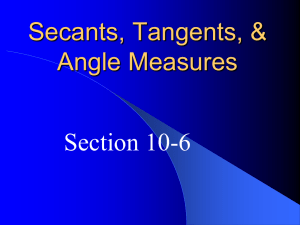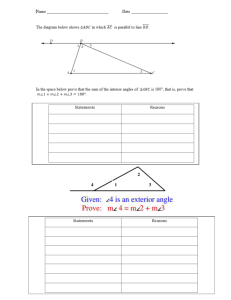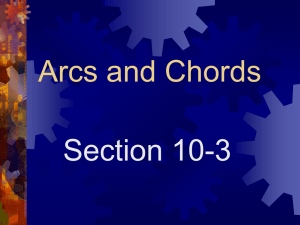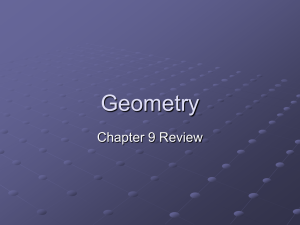File
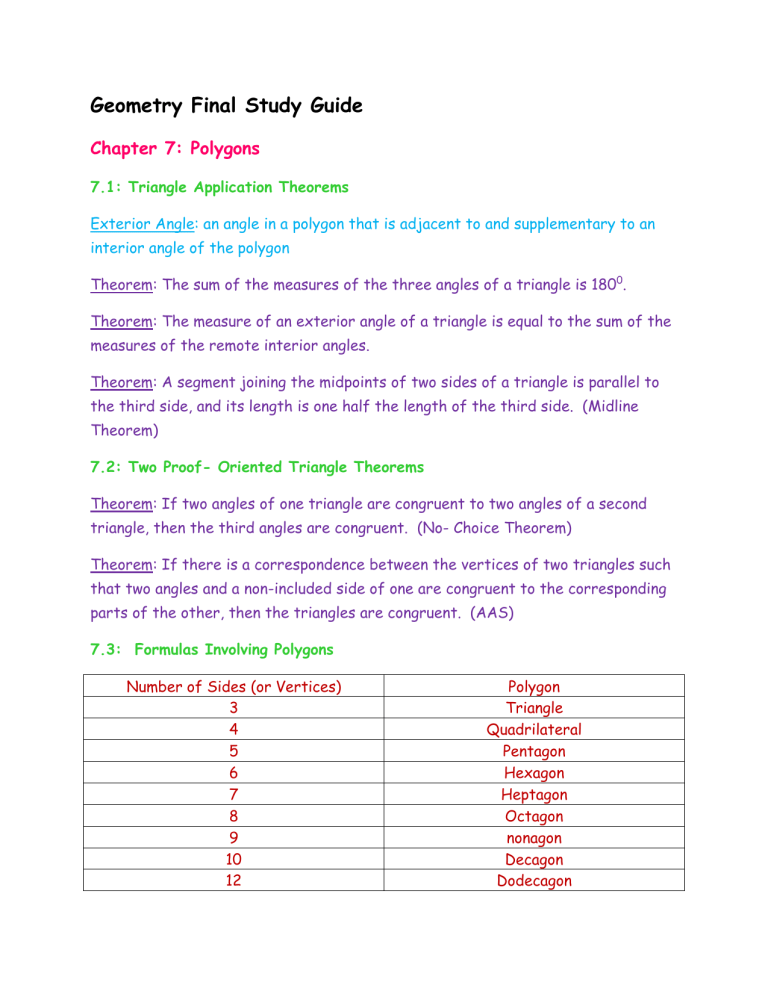
Geometry Final Study Guide
Chapter 7: Polygons
7.1: Triangle Application Theorems
Exterior Angle: an angle in a polygon that is adjacent to and supplementary to an interior angle of the polygon
Theorem: The sum of the measures of the three angles of a triangle is 180 0 .
Theorem: The measure of an exterior angle of a triangle is equal to the sum of the measures of the remote interior angles.
Theorem: A segment joining the midpoints of two sides of a triangle is parallel to the third side, and its length is one half the length of the third side. (Midline
Theorem)
7.2: Two Proof- Oriented Triangle Theorems
Theorem: If two angles of one triangle are congruent to two angles of a second triangle, then the third angles are congruent. (No- Choice Theorem)
Theorem: If there is a correspondence between the vertices of two triangles such that two angles and a non-included side of one are congruent to the corresponding parts of the other, then the triangles are congruent. (AAS)
7.3: Formulas Involving Polygons
Number of Sides (or Vertices)
3
4
5
6
7
8
9
10
12
Polygon
Triangle
Quadrilateral
Pentagon
Hexagon
Heptagon
Octagon nonagon
Decagon
Dodecagon
Theorem: The sum of the measures of the interior angles of a polygon with n sides is given by the formula: Sum= (n-2)180
Theorem: If one exterior angle is taken at each vertex, the sum of the measures of the exterior angles of a polygon is given by the formula: Sum= 360
Theorem: The number d of diagonals that can be drawn in a polygon of n sides is given by the formula: d= n (n-3)/ 2
7.4: Regular Polygons
Regular Polygon: a polygon that is both equilateral and equiangular
Theorem: The measure E of each exterior angle of an equiangular polygon of n sides is given by the formula: E= 360/n
Chapter 8: Similar Polygons
8.1: Ratio and Proportion
Ratio: a quotient of two numbers
Slope: the ratio of the rise between any two points on the line to the run between the two points
Proportion: an equation stating that two or more ratios are equal
Geometric Mean/ Mean Proportional: when the means in a proportion are equal between the extremes
Arithmetic Mean: the average of two numbers that is another kind of mean between the numbers
Theorem: In a proportion, the product of the means is equal to the product of the extremes. (Means and Extremes Products Theorem)
Theorem: If the product of any pair of non- zero numbers is equal to the product of another pair of non- zero numbers, then either pair of numbers may be made the extremes, and the other pair the means, of a proportion. (Means and
Extremes Ratio Theorem)
8.2: Similarity
Dilation: enlargement of a figure
Reduction: the opposite of dilation, when the figure is made smaller
Similar Polygons: polygons in which…
The ratios of the measures of corresponding sides are equal
Corresponding angles are equal
Theorem: The ratio of the perimeters of two similar polygons equals the ratio of any pair of corresponding sides.
8.3: Methods of Proving Triangles Similar
Postulate: If there is a correspondence between the vertices of two triangles such that the three angles of one triangle are congruent to the corresponding angles of another triangle, then the triangles are similar. (AAA)
Theorem: If there is a correspondence between the vertices of two triangles such that two angles of one triangle are congruent to the corresponding angles of the other, then the triangles are similar. (AA)
Theorem: If there is a correspondence between the vertices of two triangles such that the ratios of the measures of corresponding sides are equal, then the triangles are similar. (SSS~)
Theorem: If there is a correspondence between the vertices of two triangles such that the ratios of the measures of two pairs of corresponding sides are equal and the included angles are congruent, then the triangles are similar. (SAS~)
8.4: Congruence and Proportions in Similar Triangles
How to prove that two triangles are similar… (Using the definition of similar polygons):
Similar Polygons: polygons in which…
The ratios of the measures of corresponding sides are equal
Corresponding angles are equal
If a problem asks you to prove that the products of the measures of sides are equal, use the Means and Extremes Products Theorem.
8.5: Three Theorems Involving Proportions
Theorem: If a line is parallel to one side of a triangle and intersects the other two sides, it divides those two sides proportionally. (Side- Splitter Theorem)
Theorem: If three or more parallel lines are intersected y two transversals, the parallel lines divide the transversals proportionally.
Theorem: If a ray bisects an angle of a triangle, it divides the opposite side into segments that are proportional to the adjacent sides. (Angle Bisector Theorem)
Chapter 9: The Pythagorean Theorem
9.1: Review of Radicals and Quadratic Equations
Simplifying Radicals
Find the largest perfect square which will divide evenly into the number under your radical sign. This means that when you divide, you get no remainders, no decimals, and no fractions.
Write the number appearing under your radical as the product
(multiplication) of the perfect square and your answer from dividing.
Give each number in the product its own radical sign.
Reduce the "perfect" radical which you have now created.
Simplifying Fractional Radicals
The square root of some fractions can be determined by finding the square root of the numerator and denominator separately.
Some fractions can be reduced to fractions with perfect squares as the numerator and denominator.
For a mixed number, you have to change it to an improper fraction before finding the square root.
9.2: Introduction to Circles
Formula: Circumference= π x (Diameter)
Formula: Area of Circle= π x (Radius) 2
Formula: Arc Length= m/360 x Circumference
Formula: Area of Sector = m/360 x Area
Formula: Arc Measure= n 0
9.3: Altitude-on-Hypotenuse Theorems
Theorem: If an altitude is drawn to the hypotenuse of a right triangle, then
The two triangles forms are similar to the given right triangle and to each other.
The altitude to the hypotenuse is the mean proportional between the segments of the hypotenuse.
Either leg of the given right triangle is the mean proportional between the hypotenuse of the given right triangle and the segment of the hypotenuse adjacent to that leg. (The projection of that leg onto the hypotenuse)
9.4: Geometry’s Most Elegant Theorem
Theorem: The Square of the measure of the hypotenuse of a right triangle is equal to the sum of the squares of the measures of the legs. (Pythagorean
Theorem)
Theorem: If the square of the measure of one side of a triangle equals the sum of the squares of the measures to the other two sides then the angle opposite the longest side is a right angle.
If c is the length of the longest side of a triangle…
A 2 + B 2 > C 2 , then the triangle is acute
A 2 + B 2 = C 2 , then the triangle is right
A 2 + B 2 < C 2 , then the triangle is obtuse
9.5: The Distance Formula
Distance Formula= (x
2
- x
1
) 2 + (y
2
- y
1
) 2
Midpoint Formula= (x
1
+ x
2
/2), (y
1
+ y
2
/2)
9.6: Families of Right Triangles
Pythagorean Triple: any three whole numbers that satisfy the equation A 2 + B 2 = C 2
Common Pythagorean Triples: (3, 4, and 5), (5, 12, and 13), (8, 15, and 17), (7, 24, and 25)
9.7: Special Right Triangles
Theorem: In a triangle whose angles have the measures 30, 60, and 90, the lengths of the sides opposite these can be represented by x, x root 3, and 2x respectively.
(30-60-90 Triangle Theorem)
Theorem: In a triangle whose angles have the measures 45, 45, and 90, the lengths of the sides opposite these can be represented by x, x, and x root 2 respectively.
(45-45-90 Triangle Theorem)
Chapter 10: Circles
10.1: The Circle
Circle: the set of all points in a plane that are a given distance from a given point in the plane
Center: the given point in the plane that is an equal distance from all of the points on the edge of the circle
Radius: the given distance from the center of the circle to any point on the edge of the circle
Concentric Circles: two or more coplanar circles with the same center
Interior: a point is inside a circle if its distance from the center of the circle is less than the radius
Exterior: a point is outside a circle if its distance from the center is greater than the radius
Chord: a segment joining any two points on the circle
Diameter: a chord that passes through the center of the circle
Theorem: If a radius is perpendicular to a chord then it bisects the chord.
Theorem: If a radius of a circle bisects a chord that is not a diameter, then it is perpendicular to that chord.
Theorem: The perpendicular bisector of a chord passes through the center of the circle.
10.2: Congruent Circles
Theorem: If two chords of a circle are equidistant from the center, then they are congruent.
Theorem: If two chords of a circle are congruent, then they are equidistant from the center of the circle.
10.3: Arcs of a Circle
Arc: consists of two points on a circle and all points on the circle needed to connect the points by a single path
Central Angle: an angle whose vertex is at the center of a circle
Minor Arc: an arc whose points are on or between the sides of a central angle
(<180 0 )
Major Arc: an arc whose points are on or outside of a central angle (>180 0 )
Semicircle: an arc whose endpoints are the endpoints of a diameter (180 0 )
Measure of Minor arc/Semicircle: the same as the measure of the central angle that intercepts the arc
Measure of a Major Arc: 360 0 minus the measure of the minor arc with the same endpoints
Theorem: If two central angles of a circle (or of congruent circles) are congruent, then their intercepted arcs are congruent.
Theorem: If two arcs of a circle (or of congruent circles) are congruent, then the corresponding central angles are congruent.
Theorem: If two central angles of a circle (or of congruent circles) are congruent, then the corresponding chords are congruent.
Theorem: If two chords of a circle (or of congruent circles) are congruent, then the corresponding central angles are congruent.
Theorem: If two arcs of a circle (or of congruent circles) are congruent, then the corresponding chords are congruent.
Theorem: If two chords of a circle (or of congruent circles) are congruent, then the corresponding arcs are congruent.
10.4: Secants and Tangents
Secant: a line that intersects a circle at exactly two points (Every secant contains a chord of the circle)
Tangent: a line that intersects a circle at exactly one point of tangency/ point of contact
Tangent Segment: the part of a tangent line between the point of contact and a point outside the circle
Secant Segment: the part of a secant line that joins a point outside the circle to the farther intersection point of the secant and the circle
External Part of a Secant Segment: the part of a secant line that joins the outside point to the nearer intersection point
Tangent Circles: circles that intersect each other at exactly one point
Externally Tangent Circles: when each of the tangent circles lie outside of each other
Internally Tangent Circles: when one of the tangent circles lies inside the other
Common Tangent: a line tangent to two circles
Common Internal Tangent: when the tangent line lies between the circles
Common External Tangent: when the tangent line is not between the circles
Postulate: A tangent line is perpendicular to the radius drawn to the point of contact.
Postulate: If a line is perpendicular to a radius at its outer endpoint, then it is tangent to the circle.
Theorem: If two tangent segments are drawn to a circle from an external point, then those segments are congruent. (Two Tangent Theorem)
10.5: Angles Related to a Circle
Inscribed Angle: an angle whose vertex is on a circle and whose sides are determined by two chords
Tangent- Chord Angle: an angle whose vertex is on a circle and whose sides are determined by a tangent and a chord that intersects at the tangent’s point of contact
Chord- Chord Angle: an angle formed by two chords that intersect inside a circle but not at the center
Secant- Secant Angle: an angle whose vertex is outside a circle and whose sides are determined by two secants
Secant- Tangent Angle: an angle whose vertex is outside a circle and whose sides are determined by a secant and a tangent
Tangent- Tangent Angle: an angle whose vertex is outside a circle and whose sides are determined by two tangents
Theorem: The measure of a chord- chord angle is one half the sums of the measures of the arcs intercepted by the chord- cord angle and its vertical angle.
Theorem: The measures of a secant- secant angle, a secant- tangent angle, or a tangent- tangent angle (vertex outside of a circle) is one half the differences of the measures of the intercepted arcs.
Theorem: The measure of an inscribed angle or a tangent- chord angle (vertex on a circle) is one- half the measure of its intercepted arc.
10.6: More Angle Arc Theorems
Theorem: If two inscribed or tangent- chord angles intercept the same arc, then they are congruent.
Theorem: If two inscribed or tangent- chord angles intercept congruent arcs, then they are congruent.
Theorem: An angle inscribed in a semicircle is a right angle.
Theorem: The sum of the measures of a tangent- tangent angle and its minor arc is 180 o .
10.7: Inscribed and Circumscribed Polygons
Circumscribed Polygons: when a polygon’s sides are al tangent to the circle
Inscribed Polygons: when a polygon’s vertices all lie on the circle
Circumcenter: the center of a circle circumscribed about a polygon
Incenter: the center of a circle inscribed in a polygon
Theorem: If a quadrilateral is inscribed in a circle, its opposite angles are supplementary.
Theorem: If a parallelogram is inscribed in a circle, it must be a rectangle.
10.8: The Power Theorems
Theorem: If two chords of a circle intersect inside the circle, then the product of the measures of the segments of one chord is equal to the product of the measures of the segments of the other chord. (Chord- Chord Power Theorem)
Theorem: If a tangent segment and a secant segment are drawn from an external part to a circle, then the square of the measure of the tangent segment is equal to the product of the measures of the entire secant segment and its external part.
(Tangent- Secant Power Theorem)
Theorem: If two secant segments are drawn from an external point to a circle, then the product of the measures of one secant segment and its external part is equal to the product of the measures of the other secant segment and its external part. (Secant- Secant Power Theorem)
10.9: Circumference and Arc Length
Circumference: the perimeter of a circle
Formula: Circumference= π x (Diameter)
Formula: Area of Circle= π x (Radius) 2
Formula: Arc Length= m/360 x Circumference
Formula: Area of Sector = m/360 x Area
Formula: Arc Measure= n 0
Chapter 11: Area
11.1: Understanding Area
Postulate: The area of a rectangle is equal to the product of the base and the height for that base. (A= BH) (Where B is the length for the base and H is the measurement of the height)
Postulate: Every closed figure has an area.
Postulate: If two closed figures are congruent, their areas are equal.
Postulate: If two closed regions intersect only along a common boundary, then the area of their union is equal to the sum of their individual areas.
Theorem: The area of a square is equal to the square of any side. (A= s 2 ) (Where
s is the length of a side)
11.2: Areas of Parallelograms and Triangles
Theorem: The area of a parallelogram is equal to the product of the base and the height. (A= BH) (Where B is the base and H is the height)
Theorem: The area of a triangle is equal to one half the products of a base and the height/ altitude for that base. (A= ½ BH) (Where B is the base and H is the height)
11.3: The Area of a Trapezoid
Median: the line segment joining the midpoints of the non- parallel sides of a trapezoid
Theorem: The area of a trapezoid equals one half the products of the height and the sum of the bases. (A= ½ H (B
1
+B
2
)) (Where H is the height and B is the bases)
Theorem: The measure of the median of a trapezoid equals the average of the measures of the bases. (Median= ½ (B
1
+B
2
)) (Where B is the bases)
Theorem: The area of a trapezoid is the product of the median and the height.
(A= MH) (Where M is the median and H is the height)
11.4: Areas of Kites and Related Figures
Theorem: The area of a kite equals half the product of the diagonals. (A= ½ d
1 d
2
)
(Where d are the diagonals)
11.5: Areas of Regular Polygons
Radius: a segment joining the center to any vertex
Apothem: a segment joining the center to the midpoint of any side
Theorem: The area of an equilateral triangle equals the product of one fourth the square of a side and the square root of three. (A=s 2 /4 Square root of three)
(Where s is a side)
Theorem: The area of a regular polygon equals one half the products of the apothem and the perimeter. (A= ½ AP) (Where A is the apothem and P is the perimeter)
11.6: Areas of Circles, Sectors, and Segments
Sector: a region bound by two radii and an arc of the circle
Segment: a region bound by a chord of the circle and its corresponding arc
Postulate: The area of a circle is equal to the product of π and the square of the radius of that circle. (A=πr 2 ) (Where r is the radius)
Theorem: The area of a sector of a circle is equal to the area of the circle times the fractional part of the circle determined by the sector’s arc. (A= m/360 (πr 2 ))
(Where m is the measure of the arc and r is the radius of the circle)
Theorem: The area of a segment is equal to the difference of the area of the sector and the area of the triangle formed by two radii and the chord of the segment. (A segment
= A
sector
– A triangle
)
11.7: Ratios of Areas
Theorem: If two figures are similar, then the ratio of their areas equals the square of the ratio of the corresponding segments. (Similar- Figures Theorem)
(A
1
/ A
2
= s
1
2 / s
2
2 ) (Where A is the areas and s is the corresponding segments)
11.8: Hero’s and Brahmagupta’s Theorems
Theorem: A
Δ
= s(s-a) (s-b) (s-c), where a, b, and c are the lengths of the sides of the triangle and s= semi-perimeter= a+b+c/2 (Hero’s Formula)
Theorem: A
Cyclic Quad
= (s-a) (s-b) (s-c) (s-d), where a, b, c, and d are the sides of the quadrilateral and s= semi-perimeter= a+b+c+d/2 (Brahmagupta’s Formula)


